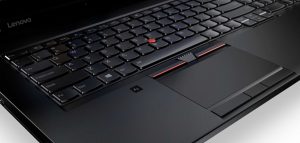Last week at GUADEC Christian gave me a huge laptop to borrow with the request to “make the color sensor work in Fedora”.
This thing is a beast: the display is 17″ and 4K resolution, two GPUs, two hard-disks and a battery. It did not fit in my laptop bag, only just squeezed in my suitcase, and weighed a metric ton. I was pretty confident I could make the color sensor work, as I previously reverse engineered the Huey and we had existing support for the embedded Huey as found in the W700 ThinkPad. Just like the W700, the sensor is located in the palm-rest, and so the laptop lid needs to be shut (and the display kept on) when showing calibration patches. I told Christian it should be a case of adding an unlock code, another PID to the udev rules and then we should be good. How wrong could I be!
Lets look on what’s shipped by default with the Laptop. In Microsoft Windows 10, the Pantone application prompts you to recalibrate your display once per week. When you manually run the calibration wizard, it asks you to choose your display temperature and also the gamma value for the curve, defaulting to D65 whitepoint and 2.2 gamma.
It then asks you to shut the lid and uses a combination of flashing the Thinkpad red-dot LED and using sound effects to show you the progress of the calibration. By opening the lid a tiny fraction we can see the pattern is as follows:
- Black offset
- Red primary
- Green primary
- Blue primary
- Red gamma ramp, 7 steps
- Green gamma ramp, 7 steps
- Blue gamma ramp, 7 steps
The USB traffic was intercepted for two runs, and dumped to CSV files. These were further post-processed by a python script to filter down and to help understand the protocol used.
From completely reverse engineering the protocol, we can show that the Pantone X-Rite sensor in the palm-rest of the P70 is nothing more than a brightness sensor with a display-specific primary correction matrix. You can’t actually get a RGB or XYZ color out of the sensor, the only useful thing that it can do is linearize the VCGT ramps, and with only 7 measurements for each channel I’m surprised it can do anything very useful at all.
Is it not known how the sensor and calibration tool can create an ICC profile without hardcoding the primaries in the sensor EEPROM itself, and this is probably what happens here. Whilst the sensor would be able to linearize a display where the hardware-corrected backlight suddenly becomes non-linear, it is completely unable to return a set of display primaries. Said another way, the sensor can’t tell the difference between a 100% red and 100% blue patch.
These findings also correlate with the findings from AnandTech who say that calibrating the display with the embedded sensor actually makes the LCD worse when measuring saturation accuracy, whitepoint and grayscale accuracy.
If you’re serious about color calibration, please don’t use the built-in sensor, and if you are buying a top-end Xeon system save a few dollars and don’t bother with the color sensor. For $20 extra Pantone could have used a calibrated XYZ one-piece sensor from MAZeT, which would have given them a true “color sensor” that could have sampled much quicker and with true XYZ-adapted readings.
The irony is of course, you can’t even use the HueyCOLOR sensor as a ambient light sensor. As the device is in the palm-rest, you frequently cover it with your hand — and any backlight adjustment would feed back into the sensor causing the backlight to flash.
If you actually want to make a colord sensor driver for this hardware we’d need to extend the capability bitfield to show it’s only capable of brightness, and also continue parsing the EEPROM to find the spectral sensitivities, but that’s not something that I think is useful to do.
If you want to know about the low-level protocol used and more information about the device, I’ve written some notes which document the protocol used. Disappointing.

Is there a way of updating the usb info or feed a bit of info through the system so people with this sensor will get a warning that their hardware is bad (and they shouldn’t feel bad) about it not working?
Otherwise, users may just see Linux not working with hardware. Criticism not worthy considering this indepth investigation here.
I did think of that; but I’m not sure what they would do with the information. It’s not like they can replace the sensor with something else….
/me strokes chin… A ColorHug2 in a P70 would be awesome, but I’m guessing the intersection of those people who care about color, those who can afford a $3000 laptop and those that are happy disassembling it probably approaches just one person.
A sidewalk slab would have been just as useful and comfortable :)
On the Lenovo workstation laptop forums, for several years now power users have commented that the built-in color sensors are worse than garbage.
To put it in some context, the LCD screens Lenovo puts in the workstation laptops are truly awful at color reproduction, unless you get the highest resolution LCD for that model. The high-res LCDs are not bad.
I guess the bean counters like the cheap stuff. But it’s sad that someone not super-well informed can spend thousands and get mediocre results :-/